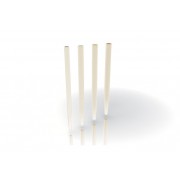Optimal cosmetic solution for prosthetic restorations
Single ceramic restorations incorporating glass-fiber posts in the laboratory
Direct restorations with glass-fiber post
Advantages
Elasticity modulus similar to dentine
Favourable constraint: deformation ratio for the tooth. Homogenous distribution of mechanical constraints
“In fact teeth restored using glass-fiber posts result in only a small number of failures, which are often repairable. In contrast, teeth restored using metal posts commonly present with more significant fractures, often resulting in the loss of the tooth.“ (Standlee, 1988; Freeman, 1998)
- Chemical retention between the core build-up and the glass-fiber post (mechanical retention only in a steel post procedure)
- Perfect aesthetic result
- Radiopacity
- No toxicities: biocompatible
- No risk of corrosion, or tissue discoloration
- Reamers from the DentoClic range
Properties
- Density - 2,680
- Axial compression modulus - 51 GPa
- Axial tensil modulus - 52 GPa
- Flexural modulus - 52 GPa
- Flexural strength - 1650 MPa
- Compression strength - 760 MPa
- Shear strength - 64 MPa
Hints and Tips
- To increase chemical interaction at the glass-fiber/bonding interface, apply silane to the surface of the post and dry thoroughly before applying bonding
(“Adhesion between fiber posts and resin luting agents: a microtensile bond strength test and an SEM investigation following different treatments of the post surface”. J Adhes Dent. 2007 Apr;9(2):195-202. Magni E, Mazzitelli C, Papacchini F, Radovic I, Goracci C, Coniglio I, Ferrari M.)
- How to remove a glass-fiber postIn comparison to other systems such as inlay-core, the clinical value of this type of restoration lies within the ease of such removal procedures.
- Remove the composite in order to gain access to the relevant post.
- Make an initial hole at the location of the insert without water to it.
- Use either a diamond-tipped, sonic or ultra-sonic insert without water, or a suitable drill, to delaminate the fiber and reveal the canal under the restoration.
- Contents
- Posts (6 violet, 6 white, 4 yellow, 4 red), 1 driver drill, 4 cylindro-conical reamers, 1 manual wrench, 1 guage


